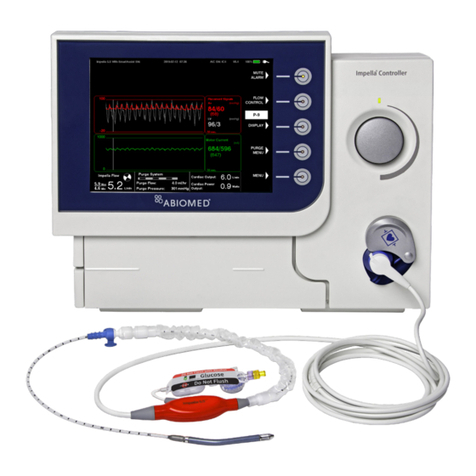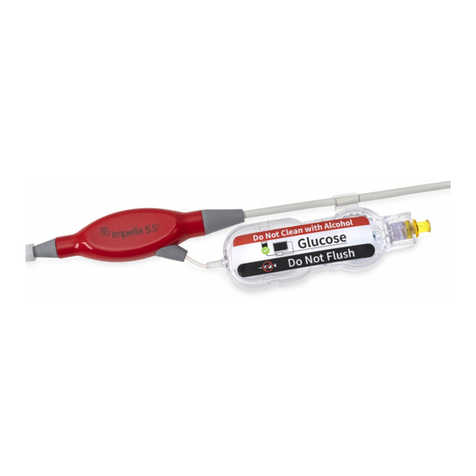
1
Impella LD®Circulatory Support System
INTENDED AUDIENCE
This manual is intended for use by cardiologists, surgeons, nurses, perfusionists, and cardiac catheterization lab technicians who have been trained in the use
of the Impella LD®Circulatory Support System.
CAUTIONS
Cautions indicate situations in which equipment may malfunction, be
damaged, or cease to operate. The light gray symbol appears before
caution messages.
Handle with care. The Impella LD®Catheter can be damaged during
removal from packaging, preparation, insertion, and removal. Do NOT
bend, pull, or place excess pressure on the catheter or mechanical
components at any time.
Patients with aortic stenosis or other abnormal aortic valve performance
may be compromised by the use of the Impella LD Catheter. Patients
with aortic valve disease should be observed for aortic insufficiency.
Physicians should exercise special care when inserting the Impella LD
Catheter in patients with known or suspected unrepaired abdominal
aortic aneurysm or significant descending thoracic aortic aneurysm or
dissection of the ascending, transverse, or descending aorta.
An incision larger than 6 mm may allow the front plug to advance into
the aorta.
Use only original accessories and replacement parts supplied by
Abiomed.
Do NOT use damaged or contaminated connector cables.
When replacing the purge cassette, the replacement process must be
completed within 90 seconds. The Impella LD Catheter may be damaged
if replacement takes longer than 90 seconds.
Do NOT kink or clamp any part of the Impella LD Catheter.
Have a backup Automated Impella Controller, purge cassette, connector
cable, and Impella LD Catheter available in the unlikely event of a device
failure.
Operation of the system without heparin in the purge solution has not
been tested. In the event that a patient is intolerant to heparin, due to
heparin-induced thrombocytopenia or bleeding, physicians should use
their clinical judgment to assess the risks versus benefits of operating
the Impella®System without heparin. If it is in the best interest of the
patient to operate the system without heparin, the dextrose solution
is still required, and physicians should consider systemic delivery of an
alternative anticoagulant. Do NOT add any alternative anticoagulant
(such as a direct thrombin inhibitor) to the purge fluid. The Impella®
Catheter has not been tested with any alternative anticoagulants in the
purge solution.
Do NOT insert the repositioning sheath into the peel-away sheath
during catheter insertion; slide the repositioning sheath towards the red
pump handle prior to inserting the device.
Never remove the guidewire when increased resistance is met.
Determine the cause of resistance using fluoroscopy and verify the
repositioning sheath is not inserted into the peal-away sheath.
In patients with transcatheter aortic valves position the Impella system
carefully to avoid interaction with the TAV prosthesis. In this situation,
avoid repositioning while the device is running; turn the device to
P-0 during repositioning or any movement that could bring the outlet
windows into proximity to the valve stent structures. If there is low
flow observed in a patient implanted with a transcatheter aortic valve
prosthesis, consider damage of the impeller and replace the Impella
pump as soon as possible.
WARNINGS
Warnings alert you to situations that can cause death or serious injury. The
dark gray symbol appears before warning messages.
Use of the Impella System by trained and experienced practitioners has
been associated with improved outcomes. Consequently, the first use
of Impella should be preceded by the completion of a contemporary
Abiomed Impella training program and include on-site proctoring during
the first use by Abiomed clinical support personnel certified in the use of
Impella.
Avoid manual compression of the inlet, outlet, or sensor areas of the
cannula assembly.
The sterile components of the Impella LD System can be used only if the
sterilization indicators show that the contents have been sterilized, the
packaging is not damaged, and the expiration date has not elapsed.
Do NOT resterilize or reuse the Impella LD Catheter. It is a disposable
device and is intended for single use only. Reuse, reprocessing, or
resterilization may compromise the structural integrity of the catheter
and/or lead to catheter failure which, in turn, may result in patient injury,
illness, or death.
Retrograde flow will occur across the aortic valve if the Impella LD
Catheter is set at P-level P-0.
Do NOT use saline in the purge system.
Do NOT use alcohol-based fluids for lubrication.
Do NOT use an Impella LD System if any part of the system is damaged.
To prevent the risk of explosion, do NOT operate the Impella LD System
near flammable anesthetics.
If at any time during the course of support with the Impella LD
Catheter, the Automated Impella Controller alarms “Purge Pressure
Low” or “Purge System Open,” follow the instructions presented in the
Automated Impella Controller manual.
Do NOT subject a patient who has been implanted with an
Impella LD Catheter to magnetic resonance imaging (MRI).
The strong magnetic energy produced by an MRI machine may
cause the Impella LD System components to stop working and
result in injuries to the patient. An MRI may also damage the
electronics of the Impella LD System.
Cardiopulmonary support (CPR) should be initiated immediately per
hospital protocol if indicated for any patient supported with the Impella
LD Catheter. When initiating CPR, reduce the Impella LD Catheter flow
rate. When cardiac function has been restored, return flow rate to the
previous level and assess the placement signal on the controller.
During defibrillation, do NOT touch the Impella LD Catheter, cables, or
Automated Impella Controller.
ENGLISH


































